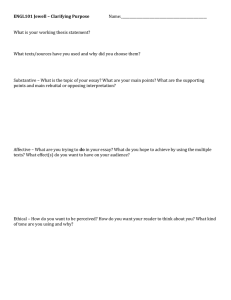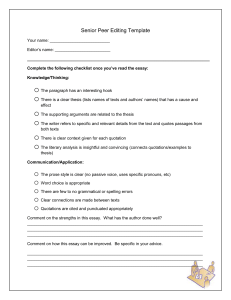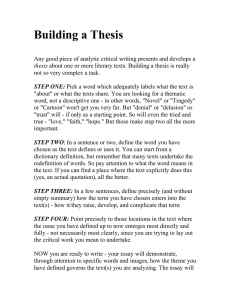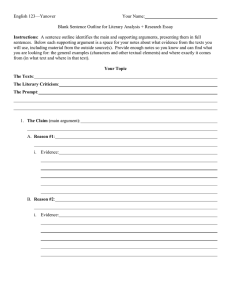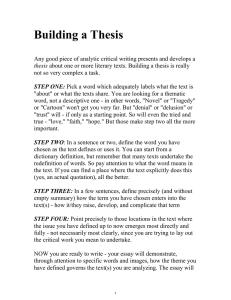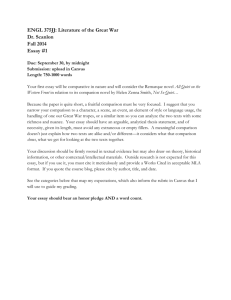Beginnings Coordinated Studies -- Fall 2007 Essentials
advertisement
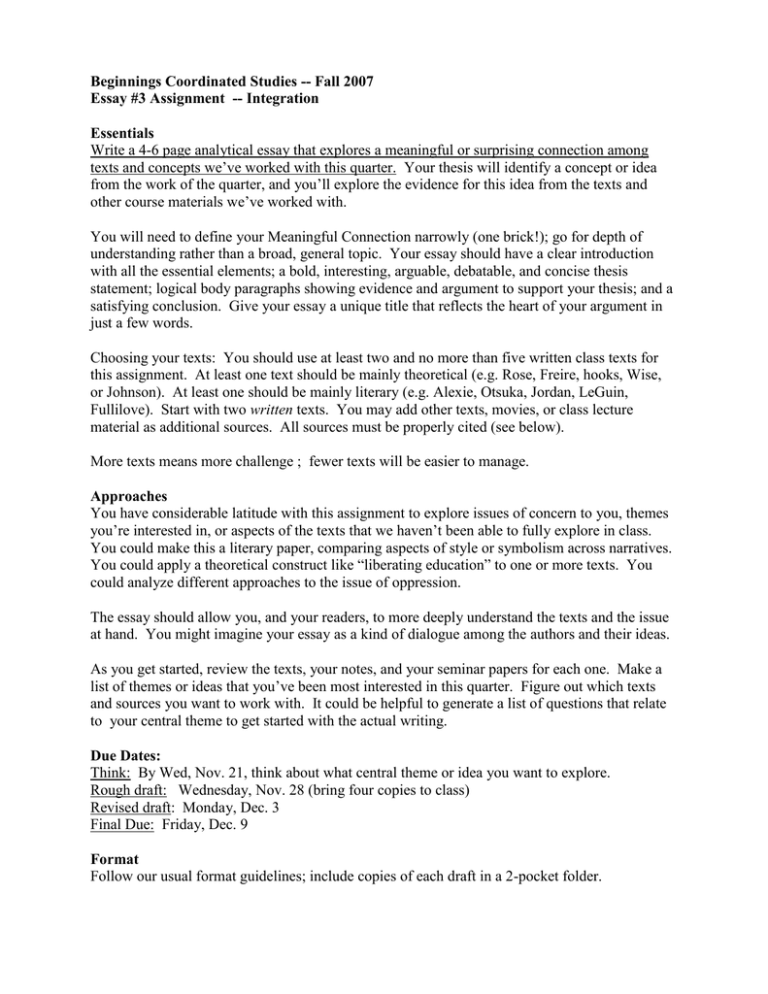
Beginnings Coordinated Studies -- Fall 2007 Essay #3 Assignment -- Integration Essentials Write a 4-6 page analytical essay that explores a meaningful or surprising connection among texts and concepts we’ve worked with this quarter. Your thesis will identify a concept or idea from the work of the quarter, and you’ll explore the evidence for this idea from the texts and other course materials we’ve worked with. You will need to define your Meaningful Connection narrowly (one brick!); go for depth of understanding rather than a broad, general topic. Your essay should have a clear introduction with all the essential elements; a bold, interesting, arguable, debatable, and concise thesis statement; logical body paragraphs showing evidence and argument to support your thesis; and a satisfying conclusion. Give your essay a unique title that reflects the heart of your argument in just a few words. Choosing your texts: You should use at least two and no more than five written class texts for this assignment. At least one text should be mainly theoretical (e.g. Rose, Freire, hooks, Wise, or Johnson). At least one should be mainly literary (e.g. Alexie, Otsuka, Jordan, LeGuin, Fullilove). Start with two written texts. You may add other texts, movies, or class lecture material as additional sources. All sources must be properly cited (see below). More texts means more challenge ; fewer texts will be easier to manage. Approaches You have considerable latitude with this assignment to explore issues of concern to you, themes you’re interested in, or aspects of the texts that we haven’t been able to fully explore in class. You could make this a literary paper, comparing aspects of style or symbolism across narratives. You could apply a theoretical construct like “liberating education” to one or more texts. You could analyze different approaches to the issue of oppression. The essay should allow you, and your readers, to more deeply understand the texts and the issue at hand. You might imagine your essay as a kind of dialogue among the authors and their ideas. As you get started, review the texts, your notes, and your seminar papers for each one. Make a list of themes or ideas that you’ve been most interested in this quarter. Figure out which texts and sources you want to work with. It could be helpful to generate a list of questions that relate to your central theme to get started with the actual writing. Due Dates: Think: By Wed, Nov. 21, think about what central theme or idea you want to explore. Rough draft: Wednesday, Nov. 28 (bring four copies to class) Revised draft: Monday, Dec. 3 Final Due: Friday, Dec. 9 Format Follow our usual format guidelines; include copies of each draft in a 2-pocket folder. Thesis Develop a thesis statement focused on your central connection that is arguable, debatable, clear, succinct, and interesting. Develop a working thesis early on in your writing process. Expect to revise the working thesis as you revise the essay – keep refining the language as you delve deeper into the texts. Structure Part of your work will be to develop a structure for your argument. A “block” organization looks at one text, makes several points about it, and then transitions to the second to make equivalent points about it, and on to the next. A “point-by-point” structure goes back and forth among the texts, comparing one point at a time. You can also use a mixed style that has elements of both block and point-by-point. It will be important to find related points and ideas among the text. For example, exploring the idea of a “banking” education, you might look at what Freire says about teachers using this system, Rose’s description of teachers in voc. ed., and LeGuin’s description of the “education” that Rakam received as a slave. You might then look at the way students respond to this type of education, first in Freire, then in Rose, then in LeGuin. The structural challenges will increase with the number of texts you use. Please give some thought to this and work with a number of texts that will be manageable, but will give you a chance to expand your skills. Use the P-I-E structure for body paragraphs. Each paragraph might look at a single work in depth, or might make a related point about more than one text. Citations Continue to use MLA style for in-text citations. Prepare a “Works Cited” page, to follow the last page of your essay. This page will list the texts you’re working with in proper MLA style, in alphabetical order. Consult the MLA information page at the Loft web site: http://dept.sccd.ctc.edu/cclib/Research_Tools/Citation_Style_Guides/north/mlacite.asp Examples of Works Cited - Crash. Dir. Paul Haggis. DVD. Lions Gate, 2005. - Le Guin, Ursula K. Four Ways to Forgiveness. New York: HarperCollins, 2004. - Nieto, L., et al. Beyond Inclusion and Empowerment: A Developmental Strategy to Liberate Everyone. Unpublished manuscript. - Stuhldreher, Karen. Lecture. Beginnings Coordinated Studies. North Seattle Community College, Fall 2007. Beginnings Coordinated Studies -- Fall 2007 Essay 3 Evaluation This essay will be evaluated as part of your final portfolio. The evaluation will be based on the following criteria: Does the essay meet the requirements of the assignment as described above? Does the essay show a close and careful reading of the texts? Does the essay lead the reader to a deeper understanding of the material? Does the introduction include all the essential elements ? Is the thesis statement focused, arguable, debatable, clearly worded, and interesting? Does the essay show evidence for the thesis, supported by logical argument? Does the paper use effective paragraph structures (PIE) and overall organization? Are text citations and works cited page accurate and complete? Does the conclusion wrap up your argument in a satisfying and compelling way? Has the essay been carefully edited for grammar, spelling, and punctuation?
